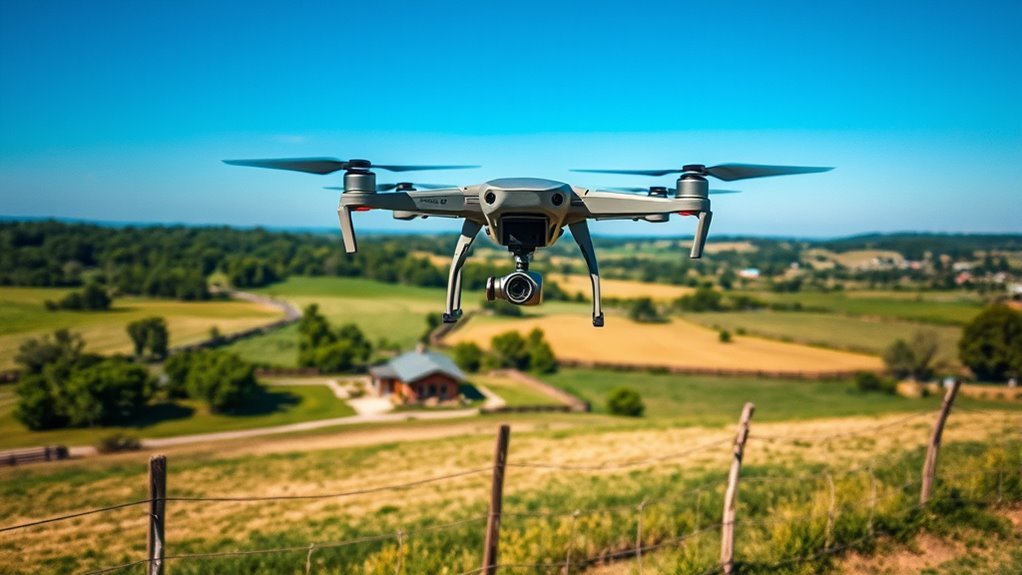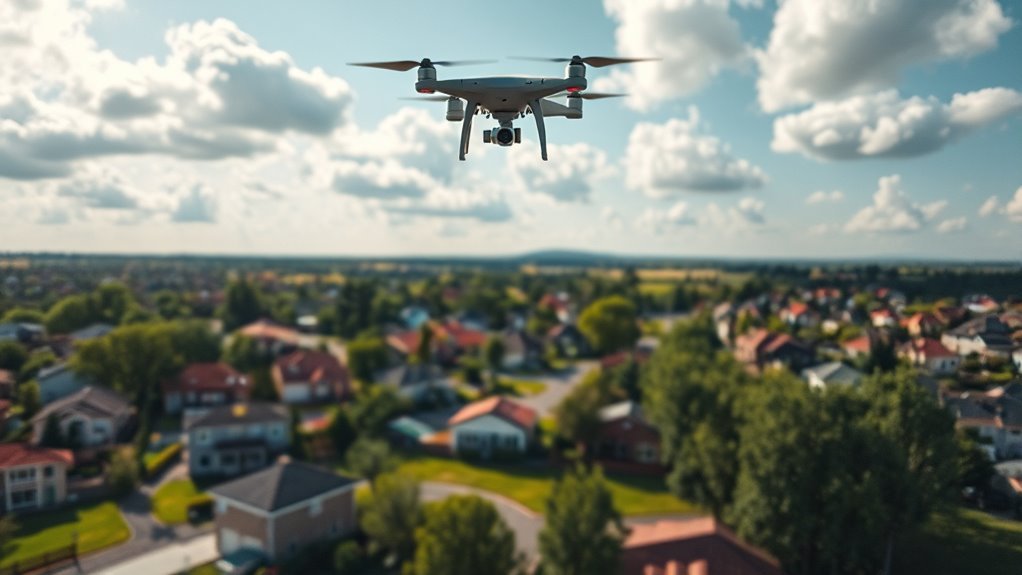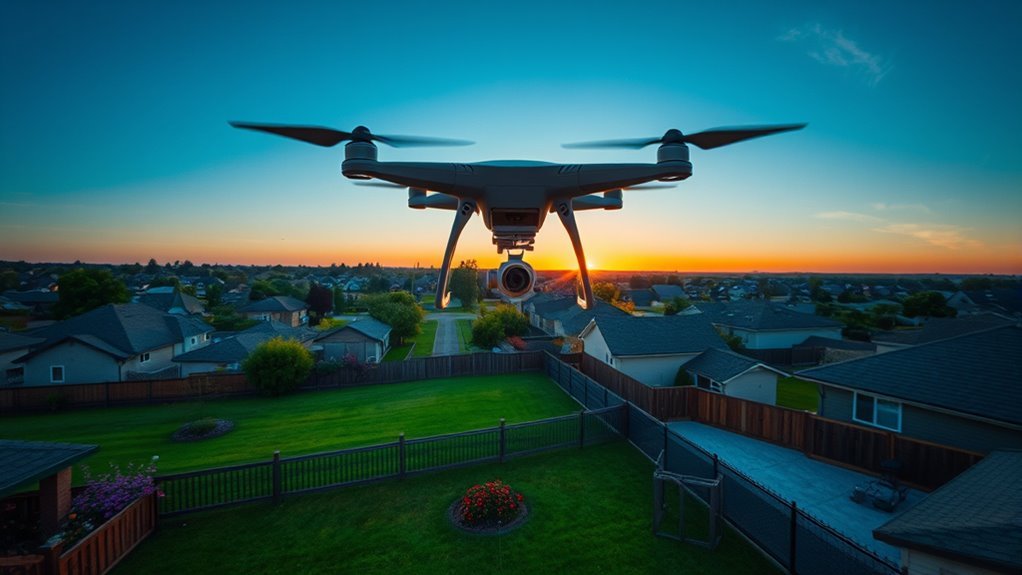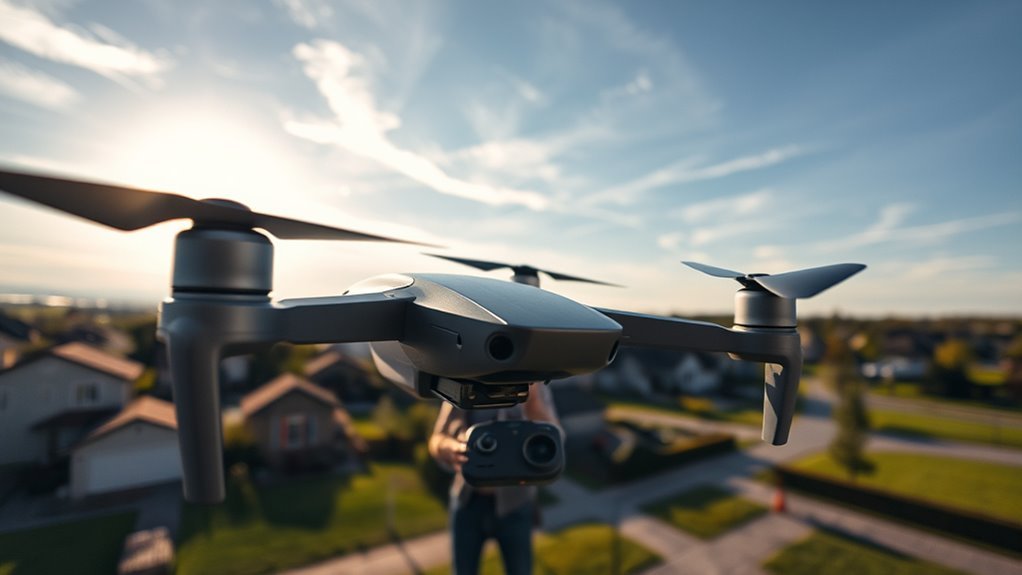When considering shooting a drone over your private property, it’s essential to understand that airspace rights are limited, usually up to about 500 feet. The FAA regulates drone operations, and local laws can vary greatly. Shooting down a drone may lead to criminal charges and liability for damages. Instead, explore non-destructive alternatives to address your concerns, like reporting unlawful activities. Knowing the legal boundaries will help you navigate this complex issue more effectively.
Understanding Property Rights and Airspace

While you may believe that owning property grants you complete control over the airspace above it, the reality is more complex. Airspace ownership isn’t absolute; it’s typically limited to a certain altitude, often just a few hundred feet above your property boundaries. This limitation arises from both legal precedents and regulatory frameworks that govern airspace use. Therefore, while you might feel entitled to protect your property from unwanted aerial intrusion, your rights are not limitless. Understanding these nuances is critical, as your authority to act against drones flying above your land may be constrained by local and federal laws. Recognizing the distinction between airspace ownership and the rights bestowed by property boundaries is essential for maneuvering these legal waters effectively. Moreover, federal regulations supersede individual claims to airspace control, making it vital to abide by established laws.
Federal Aviation Administration (FAA) Regulations

When considering the legality of shooting drones over private property, it’s essential to understand the FAA’s regulations. The FAA has authority over airspace management, which includes specific restrictions and requirements for drone registration. Familiarizing yourself with these regulations will help clarify your rights and responsibilities regarding drone interactions in your vicinity.
FAA Authority Overview
The Federal Aviation Administration (FAA) holds the primary authority over the airspace in the United States, regulating all aspects of civil aviation, including the operation of drones. Understanding the FAA authority overview is vital for anyone considering shooting drones over private property. The FAA’s drone regulations establish guidelines for where and how drones can operate, emphasizing safety and accountability. This regulatory framework means that drone operators must adhere to specific rules, ensuring that their activities don’t infringe on the rights of property owners. While the desire for freedom is understandable, it’s essential to navigate the FAA’s regulations carefully to avoid legal repercussions. Ignoring these regulations could lead to significant fines or other consequences, making compliance essential for responsible drone management.
Airspace Restrictions Explained
Understanding airspace restrictions is vital for anyone considering the legal implications of shooting drones over private property. The FAA enforces specific drone regulations that define airspace boundaries, typically categorizing it into controlled and uncontrolled zones. Controlled airspace requires permission for drone operations, while uncontrolled airspace offers more freedom, albeit still under certain conditions. You need to be aware that shooting a drone may not only violate these airspace regulations but could also lead to legal repercussions. In addition, if a drone is operating within the limits of the law, you could face penalties for interfering with its operation. Ultimately, knowing where your rights begin and end in relation to airspace boundaries is essential for responsible decision-making.
Drone Registration Requirements
How can you guarantee compliance with drone regulations? First, you need to understand that the FAA mandates drone registration for any unmanned aircraft weighing over 0.55 pounds. This process not only promotes accountability but also aids in ownership verification, which is vital for legal operations. You’ll register your drone online, paying a small fee, and receive a unique identification number. This number must be displayed on your drone, making it easier for authorities to trace ownership. Failure to register can result in fines or confiscation. So, if you value the freedom to operate your drone, taking these registration requirements seriously is important. Stay informed and compliant to fully enjoy your aerial pursuits without legal repercussions.
Local Laws and Ordinances

While many people assume that federal regulations govern all aspects of drone operation, local laws and ordinances can greatly impact where and how drones can be legally flown over private property. You need to be aware of local drone regulations, as they can vary widely from one jurisdiction to another. These laws may impose restrictions on flight altitude, designated no-fly zones, or specific times when drone flying is allowed. Understanding these regulations is vital, as violations could lead to legal repercussions or conflicts with property owners. Moreover, the property rights implications of flying over private land can complicate matters, making it essential for you to familiarize yourself with local statutes to guarantee compliance and protect your rights as a drone operator. Additionally, federal government controls navigable airspace above personal property, which can influence local drone regulations.
The Concept of Trespass in Drone Use
When considering drone use, it’s essential to understand the distinction between airspace rights and ground rights. You need to evaluate how privacy laws and property owner permissions influence the legal landscape surrounding potential trespass. This understanding informs both your responsibilities and the rights of property owners in relation to drone operations.
Airspace vs. Ground Rights
Although the concept of airspace ownership may seem straightforward, it becomes complex when considering drone use over private property. You might assume that property ownership grants you control over everything above your land, but airspace boundaries aren’t as clear-cut. In many jurisdictions, landowners have rights extending only to a certain height, typically considered to be around 500 feet. Drones flying above this threshold often operate within navigable airspace, which is regulated by federal authorities. This creates potential for conflict between your property rights and the rights of drone operators. Understanding these nuances is essential, as you navigate the legal landscape surrounding drone use. Ultimately, knowing your rights can empower you to protect your interests while respecting the boundaries of airspace governance.
Privacy Concerns and Laws
With the complexities of airspace rights established, the focus shifts to privacy concerns arising from drone use over private property. You need to understand that drone surveillance can lead to privacy violations, raising significant legal and ethical questions. While airspace may be public, your expectation of privacy remains crucial when it comes to your property. Courts often evaluate whether a drone intrudes upon that reasonable expectation. If a drone captures images or recordings without consent, it may constitute a trespass, even if it operates legally in the airspace above. As a result, knowing your rights is essential to protect against unauthorized drone activities, ensuring that your privacy is respected while maneuvering the evolving landscape of drone legislation.
Property Owner Permissions
Understanding the concept of trespass in drone use is essential for property owners who want to protect their rights. You need to be aware that drone photography permissions are often required if the drone operator intends to capture images over your property. Property access laws vary by jurisdiction, but generally, you have the right to control who enters your airspace. If a drone flies over your land without permission, it may constitute trespass, potentially allowing you to take legal action. To safeguard your interests, consider posting visible signs to indicate that drone photography is not permitted. Staying informed about local regulations can empower you to enforce your rights effectively while respecting the balance between freedom and property ownership.
Property Owners’ Rights to Defend Their Property
As property owners seek to protect their domain, they must navigate a complex landscape of legal rights and responsibilities. Your right to defend your property includes taking measures against unwanted intrusions, including drones. However, the legality of drone deterrence can vary considerably by jurisdiction. While you may feel justified in shooting down a drone invading your privacy, it’s essential to understand that such actions could lead to legal repercussions, including potential criminal charges and penalties. Property defense must be balanced with respect for airspace laws and drone regulations. Before taking any action, consider the potential consequences and alternative methods of deterrence, such as reporting the intrusion to authorities. Ultimately, knowing your rights empowers you to protect your property effectively and legally. Furthermore, it’s crucial to recognize that federal laws regulate drone use to ensure safety and privacy in national airspace.
Liability Concerns for Shooting Drones
Even if you believe your actions are justified, shooting down a drone can expose you to significant liability concerns. The potential for drone damage is substantial, whether it’s to the drone itself or to surrounding property and individuals. If you decide to take this drastic measure, you may face lawsuits from the drone’s owner, claiming damages or invasion of privacy. Liability insurance can mitigate some financial risks, but it may not cover all scenarios, especially if you acted recklessly. Furthermore, local laws might impose strict penalties for discharging a firearm in such contexts. As a result, weighing the risks and understanding the legal implications before taking action is essential to safeguard your interests and avoid costly legal battles.
Alternatives to Shooting Down Drones
When considering alternatives to shooting down drones, it’s essential to understand the legal consequences that may arise from such actions. Fortunately, there are non-destructive solutions available that can effectively address the presence of unwanted drones. Exploring these options allows you to protect your privacy while minimizing potential legal repercussions.
Legal Consequences Explained
While the temptation to shoot down a drone hovering over your property may be strong, the legal consequences of such an action can be severe. Engaging in this behavior can lead to significant legal implications, including criminal charges for property damage or even endangerment. Law enforcement may face challenges in enforcing regulations, as the legality of drone operations often intersects with property rights and airspace laws. You could find yourself embroiled in costly legal battles that undermine your desire for freedom and privacy. Instead of resorting to drastic measures, consider exploring lawful alternatives that safeguard your rights without incurring such risks. Understanding the legal landscape is essential in maneuvering through these complex issues while preserving your freedoms and protecting your property.
Non-Destructive Solutions Available
Taking drastic measures against drones can lead to serious legal issues, so it’s important to explore non-destructive solutions that address your concerns without the risks associated with shooting them down. Here are some effective non-destructive methods for drone mitigation:
| Method | Description |
|---|---|
| Signal Jammers | Disrupt drone communication signals. |
| Drone Detection Systems | Identify and track drone activity. |
| Visual Deterrents | Use flags or balloons to deter drones. |
| Legal Notices | Post warnings to inform drone operators. |
These solutions allow you to protect your privacy and property while avoiding legal ramifications. By employing non-destructive methods, you can assert your rights without compromising your freedom or safety.
Best Practices for Drone Pilots
Understanding the legal landscape surrounding drone operation is essential for pilots, especially when traversing private property. To navigate this terrain effectively, you should prioritize education and familiarize yourself with local regulations. Adhering to safety protocols is non-negotiable; they not only protect you but also safeguard the public and property. Always conduct pre-flight checks to verify your equipment is functioning correctly and remain aware of your surroundings. Additionally, ensure that your drone is properly registered, as registration is required for drones over 0.55 pounds (250 grams) before outdoor flight. Respecting no-fly zones and maintaining a safe distance from private properties can prevent conflicts. Additionally, consider joining a community or seeking mentorship from experienced pilots to enhance your knowledge. By committing to ongoing pilot education, you’ll not only improve your skills but also contribute to a culture of responsible drone operation. Furthermore, ensure you understand drone regulations in your area to avoid legal complications.
How to Report Unlawful Drone Activity
How can you effectively report unlawful drone activity? First, familiarize yourself with the local reporting procedures for drone violations. Document the incident by noting the time, location, and any identifying features of the drone, such as its color or markings. If possible, take photos or videos as evidence. Next, contact local law enforcement or your municipality to file a formal complaint, providing them with the details you’ve gathered. Some areas may also have specific agencies that handle drone-related issues, so check for those resources. Finally, consider reaching out to the Federal Aviation Administration (FAA) if the drone’s operation poses a threat to airspace safety. Reporting these violations is essential for maintaining your rights and ensuring responsible drone use in your community.
The Future of Drone Legislation and Property Rights
As the use of drones becomes more prevalent, the intersection of drone legislation and property rights is likely to evolve considerably. Future legislation will need to address the growing number of property disputes arising from drone usage, as individuals seek to protect their rights while balancing technological advancements. You’ll see lawmakers grappling with questions about airspace ownership and privacy, creating a complex legal landscape. As drones become more integrated into everyday life, it’s essential for you to stay informed about potential changes in legislation that may affect your property rights. Engaging in discussions about these issues may help shape future laws that respect your freedoms while ensuring responsible drone operation. The outcomes will influence how drones intersect with private property in the coming years.
Frequently Asked Questions
Can I Shoot Down a Drone if It’S Hovering Above My Property?
You can’t just shoot down a drone hovering over your property. Drone rights and property laws typically protect drone operations, so it’s essential to understand legal implications before taking any action that could lead to consequences.
What Are the Consequences of Shooting a Drone Illegally?
If you shoot a drone illegally, you might face serious legal repercussions, including fines and potential criminal charges. Understanding drone regulations is essential to avoid costly mistakes that could infringe on your freedom and property rights.
How Can I Identify the Owner of a Drone?
To identify a drone’s owner, check for drone registration numbers displayed on the device. You can also contact local aviation authorities to assist in owner identification, as they maintain records of registered drones and their operators.
Are There Specific No-Fly Zones for Drones?
Yes, there are specific no-fly zones for drones. Drone regulations often outline airspace restrictions near airports, military bases, and other sensitive areas, ensuring safety and privacy. Always check local laws to stay compliant.
Can I Use Non-Lethal Methods to Disable a Drone?
Nearly 80% of drone incidents involve privacy concerns. You can use non-lethal devices, such as drone jamming technology, to disable drones. However, be aware of legal implications and local regulations before taking action.

